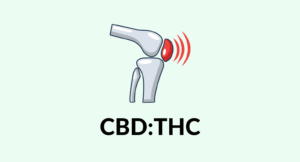
Evidence based
CBD for Sciatica: How It Works, Safety, Drug Interactions, & Best Products
Cannabidiol (CBD) is a popular natural health supplement with broad-acting anti-inflammatory, muscle relaxant, and pain-relieving properties that make it a gentle and effective option for those looking to address muscle and nerve pain — like sciatica.
Here’s everything you need to know about how using CBD for sciatica symptoms.
What Is Sciatica?
Sciatica is a peripheral neuropathic pain disorder that occurs when the sciatic nerve is damaged, pinched, or compressed. This often happens as the result of a herniated disk, bone spur on the spine, or spinal stenosis.
The pain associated with sciatica can take the form of sharp pain, numbness, tingling in the lower back that jolts down into the affected leg. For some patients, even simple spasms like sneezing can cause acute sciatica pain.
Sciatic nerve damage is often easily remedied, but it can also become a chronic disorder that may require surgery. Nonetheless, sciatica is painful and uncomfortable and produces significant inflammation in the body.
How Is Sciatica Treated?
Treatments for sciatica are usually focused on reducing inflammation and muscle spasms, managing pain, and preventing future injuries.
Although some sciatica patients need further care, most people can move on from sciatic nerve pain after a relatively short time with at-home care after a visit from a movement rehabilitation clinic.
Caring for sciatica at home is as simple as soothing the muscles and reducing the inflammation as much as possible. Taking a warm bath in Epsom salts, icing and heating the lower back, and taking anti-inflammatory medication can all help reduce sciatica symptoms.
It’s a good idea to talk to your doctor about sciatica if the symptoms persist beyond a few weeks.
How CBD Works For Sciatica
Cannabidiol (CBD) is the main pharmacologically active component in hemp plants that have been shown to have broad-acting applications towards pain, healthy stress management, and much more.
CBD primarily alleviates pain by targeting the nerve cells directly. This makes it especially promising for nerve-related pain such as sciatica.
Here’s how it works:
CBD Reduces Inflammation
One of the leading causes of pain is inflammation.
When it comes to sciatica, inflammation may cause swelling that pinches or compresses the sciatic nerve in the low back. When it comes to managing sciatica pain, reducing inflammation through heat and cold therapy and non-steroidal anti-inflammatory drugs (NSAIDs) are popular treatment methods.
CBD is an excellent anti-inflammatory compound because it works through multiple pathways involved with the inflammatory response compared to many anti-inflammatory medications, which only address one enzyme in the inflammatory process [1].
Related article: CBD For Inflammation
CBD May Offer Some Relief For Nerve Pain
Nerve pain or neuropathic pain is difficult to treat, but CBD has been shown to be effective at supporting neuropathic conditions through its unique interactions in the endocannabinoid system.
Not only does CBD reduce inflammation, as we’ve previously mentioned, but it increases anandamide levels — a neurotransmitter that binds to endocannabinoid receptors that stimulate bliss and wellness, which can help to manage pain.
CBD has also been shown to activate vanilloid and opioid receptors to block pain signals from the nerve to the spinal cord and brain. These findings have been observed in both internal consumption of CBD (smoking and eating) as well as topical applications [3].
In a recent study, patients reported a significant reduction in pain and uncomfortable symptoms, like itchiness or cold sensations, after using CBD oil to topically treat peripheral neuropathy [2].
CBD Has A Much Lower Risk For Abuse
Pain is the number one reason people become hooked on dangerous opioid drugs.
Several of the drugs used to treat sciatica pain are habit-forming, and tolerance is quickly developed. CBD is most effective for addressing pain in inflammation at higher doses (50 mg CBD or more). The good thing is that CBD is found to be well-tolerated and has very minimal, short-term adverse effects [4].

How To Use CBD For Sciatica
There are many different ways to use CBD for sciatica. For most people, this stubborn source of pain requires some pretty aggressive action. This means applying a high-strength CBD topical to the area (local pain relief) and taking some high-potency CBD oil, capsules, or gummies.
Some people even find topping these effects up with a few puffs on a vape pen every now and then help keep the pain control consistent and long-lasting.
1. CBD Oils For Sciatica
CBD oils come in all shapes and sizes. If your goal is to use it for general health and wellness, a simple 1000 mg oil should do the trick.
However, if your goal is to use it for hard-to-treat neuropathic pain conditions, such as sciatica, you’re very likely to need something much stronger.
Aim for something with at least 60 mg per mL. This works out to around 2000 mg per 1 oz (30 mL) bottle.
Full-spectrum oils are generally considered superior for managing nerve pain to a CBD isolate.
Related: Check out our list of the best CBD oils on the market.
2. CBD Gummies For Sciatica
Oils and gummies serve the same purpose. CBD gummies are just a little bit more pleasant to use and makes figuring out the dosage simpler.
Look for gummies with high-potency broad-spectrum or full-spectrum extract. Most gummies are made from CBD isolate, which won’t work quite as well for nerve pain. Many of the other cannabinoids aside from CBD have analgesic and neuroregulatory benefits.
Related: Best CBD Gummies For Pain.
3. CBD Topicals For Sciatica
Many people with sciatica choose to combine both internal CBD (like oils or gummies) with a topical.
CBD topicals have faster relief but won’t work as thoroughly or for as long.
Your best bet is to opt for a high-potency, full-spectrum topical with at least 6 mg per mL (more is even better).
We like topicals with other painkilling ingredients the best — such as the Pain Cream from Kiara Naturals (Called Joint Cream, but it works for all sources of pain). This formula includes camphor, arnica, and menthol for added effect.
4. Other Cannabinoids For Sciatica
CBD isn’t the only cannabinoid with pain-killing benefits. When it comes to neuropathic-specific pain, the other options to consider are CBG (cannabigerol), CBN (cannabinol), THC (both delta 8 THC and delta 9 THC), and a novel cannabinoid called THCC.
Related: Best CBD:THC Ratio For Neuropathic Pain.

Will CBD Interact With My Sciatica Medications?
All drugs that have a pharmacological effect bring the risk of side effects or interaction with other drugs or supplements. CBD is no different.
While this compound has a very high level of safety and isn’t known to cause any major side effects on its own, it could interfere with the effects of other, more dangerous prescription medications.
Common sciatica medications and their potential for negative drug interactions with CBD include:
A) Anti-inflammatories
CBD may interact with anti-inflammatory drugs by slowing the metabolism in the liver. It’s unlikely for there to be any major side effects with this combination, but it’s wise to speak with your doctor if you’re using corticosteroids like prednisone and want to take CBD.
B) Muscle Relaxants
Muscle relaxants used for sciatica include Lioresal (baclofen), Soma (carisoprodol), Lorzone (chlorzoxazone), and Fexmid (cyclobenzaprine).
All of these medications bring a high risk of side effects. Combining CBD with these medications could (theoretically) lead to a higher incidence of side effects. However, in practice, side effects from this interaction are uncommon. Always speak to your doctor before combining CBD with muscle relaxants.
C) Opioid Pain Medications
Opiates are, by far, the most common and potent class of painkillers. They work for all kinds of pain, including neuropathic pain conditions like sciatica.
The problem is that opioids commonly lead to side effects, can be addictive, and have the potential to cause overdose if used incorrectly.
CBD and opioids have a moderate to low risk of negative interaction but should be used very cautiously together.
CBD could slow the metabolism and elimination of these medications, leading to a buildup of the drug in the body with repeated doses. This could be very dangerous.
CBD may interact with drugs such as buprenorphine, hydrocodone, oxycodone, tramadol, and others.
D) Antidepressants
Depression is a common side effect of any chronic pain condition — including but not limited to sciatica.
For this reason, it’s common for doctors to prescribe antidepressants along with other, more direct medical interventions.
CBD has the potential to interact with all major classes of antidepressants, including SSRIs, SNRIs, MAOIs, and tricyclic antidepressants.
In most cases, the interaction won’t cause any noticeable side effects, but sensitive individuals or people taking high doses of both the drug and CBD may experience adverse reactions with this combination. Talk to your doctor if you’re on any prescription antidepressants.

Summary: CBD Oil For Sciatica
Sciatica is a painful and uncomfortable peripheral neuropathy disorder. It’s often treated with muscle relaxants, anti-inflammatory drugs, and narcotics, but CBD can treat all the same symptoms these drugs seek to fix.
CBD can reduce inflammation, calm muscle spasms, and reduce pain associated with nerve damage. Using CBD for sciatica is as simple as rubbing a topical on the lower back and leg or taking an oral CBD product.
Be cautious about using CBD if you’re taking any prescription medications to manage your symptoms. Speak with your doctor before using CBD to ensure there aren’t any potential red flags about mixing CBD with your medications.
References
- Atalay, S., Jarocka-Karpowicz, I., & Skrzydlewska, E. (2020). Antioxidative and anti-inflammatory properties of cannabidiol. Antioxidants, 9(1), 21.
- Xu, D. H., Cullen, B. D., Tang, M., & Fang, Y. (2020). The effectiveness of topical cannabidiol oil in symptomatic relief of peripheral neuropathy of the lower extremities. Current pharmaceutical biotechnology, 21(5), 390-402.
- Costa, B., Trovato, A. E., Comelli, F., Giagnoni, G., & Colleoni, M. (2007). The non-psychoactive cannabis constituent cannabidiol is an orally effective therapeutic agent in rat chronic inflammatory and neuropathic pain. European journal of pharmacology, 556(1-3), 75-83.
- Abraham, A. D., Leung, E. J., Wong, B. A., Rivera, Z. M., Kruse, L. C., Clark, J. J., & Land, B. B. (2020). Orally consumed cannabinoids provide long-lasting relief of allodynia in a mouse model of chronic neuropathic pain. Neuropsychopharmacology, 45(7), 1105-1114.
- Xiong, W., Cui, T., Cheng, K., Yang, F., Chen, S. R., Willenbring, D., … & Zhang, L. (2012). Cannabinoids suppress inflammatory and neuropathic pain by targeting α3 glycine receptors. Journal of Experimental Medicine, 209(6), 1121-1134.










